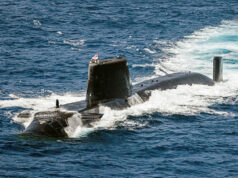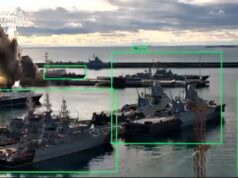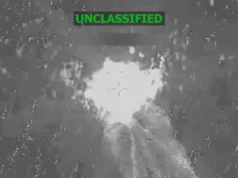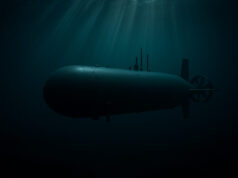It has been reported that the announcement of a contract award to MBDA for a naval laser weapon demonstrator has been held up by one of the losing bidders.
DefenseNews say here:
“Thales UK filed the protest after missile-maker MBDA was selected in mid-July.”
In July we reported that MBDA had been selected to demonstrate British laser weapons for use on Royal Navy warships.
It had been speculated that the MoD was due to select a contractor to build a technology demonstrator to validate a laser weapon system.
It is understood that the laser would be ‘co-mounted’ with the Phalanx’s cannon, rather than replacing it altogether.
Raytheon, a rival bidder, had showed a possible configuration with a laser and the 20mm Phalanx fitted alongside a radar and optronics. This image is shown above.
The Royal Navy already widely uses the Phalanx across its fleet.
According to multiple reports, the Royal Navy would add to its stock of Phalanx by purchasing additional weapons at some point. Close-in weapon systems remain a shipboard necessity for detecting and engaging missiles and aircraft at short range.
This news will see Britain join the laser arms race after America has already deployed a laser to the Gulf on one of its own warships.
Former First Sea Lord, Admiral Sir George Zambellas, made an announcement foreshadowing this last year. He claimed that Britain will test a prototype laser cannon on its warships by the end of the decade.
The “directed energy weapon” will be able to fire high energy beams to damage and burn up targets at the cost of only pence per shot.
America deployed a working laser weapon system on board USS Ponce in the Gulf last year. The laser has been successfully tested shooting down drone aircraft and burning up small attacking boats, or at lower power to “dazzle” sensors and instruments. The AN/SEQ-3 Laser Weapon System reportedly worked perfectly, indeed the commander of the Ponce is authorised to use the system as a defensive weapon.
Laser weapons are an increasing focus for defence firms and expected to become more common on the battlefield in the next decade.
In May, Raytheon claimed the first test firings could take place in 2018.













Andrew Brown
Good grief they lost the bid it’s simple
Well…every UK MoD competition has a period set aside immediately after the bid winner announcement to allow the losing bidders to raise objections and if necessary protest against the decision. Usually (in my experience anyway) losing companies seldom take this option as it can reflect poorly on the company concerned if they are regular bidders for MoD contracts. That said, there are always exceptions, especially if the company protesting feels they have a genuine edge to their bid that seems to have been undervalued or they believe that the MoD competition process was not run as described at the competition start, which in itself may have lead to the wrong choice.
These things draw a lot of power .. who’s going to get the contract for a power source ? .. and what ships barring the new Carriers would be capable of powering these systems ? … not to mention an overcast day renders such systems ineffective, do we really need another white Elephant at this time.
Modern systems can shoot through fog, clouds, rain etc.
Nice to know we UKDJ members who seem to know such good stuff about modern laser capability! 🙂 Still – such classified information is no doubt freely available through WikiLeaks!
We haven’t written anything that’s classified.
Well atmospheric conditions will diffract and interfere with a Laser beam thus reducing power or widening the beam to such an extent that it becomes nothing more than a blinding weapon … an option around this is to turn up the power, but this reduces the life of the optics.
UK Defence Journal OOps I think you were collateral damage from my comment …not aimed at you of course….obviously need laser weapons to be sure of impact next time! 🙂
Michael John Smith Very good….yes indeed good basic physics.
Even the latest solid state fibre optic coherent/incoherent combined lasers have problems with heat and so they are low power, they are only capable of generating a combined 40 kW beam, any higher simply melts the fibres and they still have the problem of atmospheric diffusion …. a useful laser needs to be in the Megawatt range .. Megawatt range has all sorts of problems, heat dissipation, thermal blooming, power generation, etc etc … operational Lasers are at least 10 years away .. if ever.
Surely the UK is a world leader in Scalar weaponry anyway .. so why go down this laser dead end when Scalar weapons make everything else redundant? … smacks of corporate welfare.
About time they got with the times and develop the advanced weaponry instead of cat farting around with it !
Why not make it a serious competition where the losing bidders get shot in a firing squad without appeal. Bwa ha ha ha!
and really rub it in by the shooting must be done with the winning system…. (probably 😉 )
Richard Hardwick I’ll drink to that. Let the Hunger Games begin. lol!
Sigh
Death ray